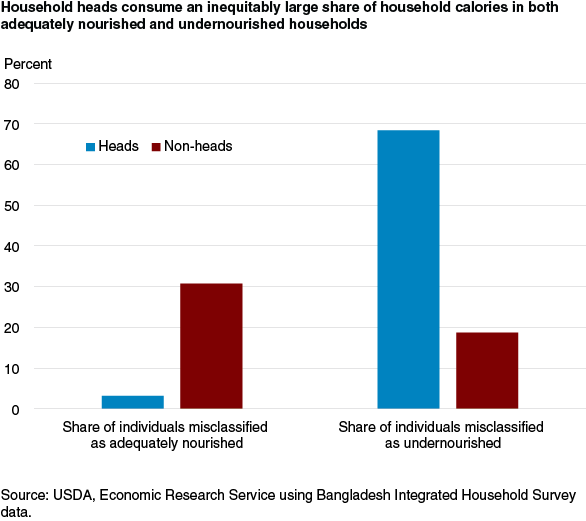Household-Level Data Might Not Accurately Characterize Food Insecurity: Evidence From Bangladesh
- by Anna D'Souza and Sharad Tandon
- 11/2/2015
Recent episodes of high global food prices have heightened interest in accurate measurement of the world’s food-insecure population. Given data limitations, the measurement of food insecurity is often based on data aggregated at the household level, under the assumption that calories are distributed equitably within each household. However, ERS research on Bangladesh has found that this assumption isn’t always accurate, resulting in the food security status of a large share of the population being misclassified when relying on household-level data. Although estimates of the size of the food-insecure population based on household and individual-level data are similar, the food security status of individuals is not accurately identified by household-level data, which makes it more difficult to effectively target the most vulnerable population with food aid.
Using survey data collected by the International Food Policy Research Institute between December 2011 and March 2012 on rural Bangladesh (which reports consumption for nearly 22,000 individuals from approximately 5,300 households), ERS researchers computed two separate assessments of food security. In the first, calorie consumption for each individual was calculated and individuals who consumed less than their minimum daily energy requirement (MDER) were classified as undernourished. In the second, calorie consumption for each individual in a household was summed together, and every individual in the household was classified as undernourished if the total household calories were less than an amount that could meet the MDER of each individual in the household (similar to typical household-level assessments). The two estimates can diverge if calories are not equitably distributed amongst household members.
Using these two different estimates of consumption, researchers identify individuals who would be misclassified when solely relying on household-level estimates. Some individuals are undernourished but living in adequately nourished households (based on household-level estimates); other individuals are adequately nourished but live in households that are identified as undernourished based on household-level estimates. Researchers found that over a quarter of the population of rural Bangladesh would be misclassified when using aggregated household-level data to measure undernourishment. An analysis revealed that household heads (the vast majority of whom are male) are much more likely to be adequately nourished than their spouses or children in undernourished households. Similarly, spouses and children were found much more likely to be undernourished in adequately nourished households.
This article is drawn from:
- D'Souza, A. & Tandon, S. (2015). Using Household and Intrahousehold Data To Assess Food Insecurity: Evidence from Bangladesh. U.S. Department of Agriculture, Economic Research Service. ERR-190.



